There are a lot of misconceptions and myths surrounding inflatable kayaks. Unfortunately I think these myths cause consumers to doubt whether an inflatable kayak is the right choice.
I will go through these myths below and clear up any confusion or misconception that people may have.
Hopefully this will help those who have never used a good inflatable kayak to feel comfortable and well informed about their decision to possibly purchase one.
Myth #1 – Inflatable Kayaks are Not Durable
It makes sense to think that an inflatable is simply not going to hold up like a hard-shell kayak. However the truth is they are known to hold up just as well… if not better.
There are a variety of heavy-duty materials used in constructing inflatable kayaks such as PVC, Hypalon, and Nitrylon. These materials are unbelievably tough and sturdy. The fabrics tend to be multi-layered and heavily reinforced and the seams are either electrically welded or glued.
Myth #2 – Inflatable Kayaks will Sink if they Get a Tear
Not true. Inflatable kayaks are actually known as the unsinkable boats. Even when they are completely filled with water, they will not sink.
A tear in your kayak is really not a big deal. Each inflatable kayak will always have more than one air chamber so even in the unlikely event that one should completely deflate, you will still be afloat. Truthfully though, if there is a tear your leak will be so slow that you will have no problem getting back to shore before much air comes out.
Each inflatable kayak comes with its own repair kit and you can do a quick patch-up repair, or if the leak is really bad you can always send it in to the manufacturer.
Myth #3 – Inflatable Kayaks Must Avoid Sharp Objects
The fact is that some inflatable kayaks are built tougher than others. If you plan on paddling in rivers and know that you will be bumping up against rocks and sticks then you will want an inflatable kayak that is specifically designed for whitewater use.
These inflatable kayaks will have been heavily tested with bumps, sharp objects and all sorts of river obstructions. If you get a decent to good model this is nothing to worry about. Even most flat water inflatable kayaks are not susceptible to easy tears and abrasions.
As far as avoiding sharp objects – well yeah that would be a good idea. As a general rule it is pretty difficult to actually puncture an inflatable kayak but it can happen. Just be on the lookout.
Myth #4 – Inflatable Kayaks cannot be Dragged on Gravel or River Banks
It is expected that there will be some dragging of the inflatable kayak on sand or gravel while getting to shore or on river banks. They are built to handle it but as a general rule I am fairly conscious of this myself.
There will be some scratches but if you are semi-careful about it your inflatable kayak should stay in really good shape. Same as any boat, it is up to you what kind of beating you give it.
Myth #5 – Inflatable Kayaks are Not Stable
Inflatable kayaks as a general rule are actually much more stable than a hard-shell kayak. This is because inflatable kayaks usually have quite flat bottoms and are therefore extremely stable on the water.
With some models you can even stand up in them with no problem. Also inflatable kayaks have multiple air chambers which make them very buoyant and difficult to tip. Keep in mind that usually the wider the kayak, the more stable it will be.
Myth #6 – Inflatable Kayaks Are Hard to Maneuver
This will all depend on the model you choose. Some inflatable kayaks will not even compare in performance to a decent hard-shell kayak. However, I have been in some pretty awful rigid kayaks that did not compare to the maneuverability of my inflatable kayak. So it really depends on which kayak you are paddling in.
Often an inflatable kayak will come with a skeg or an optional rudder which will greatly help with the tracking and the maneuverability on flat water. I know of people who paddle their inflatable kayaks on the ocean from island to island with great success and with no problems in maneuverability so it really depends on the model.
Myth #7 – Inflatable Kayaks are Difficult to Care For
If you know what to do, I think inflatable kayaks are the simplest boats to care for. There is no big maintenance that must be done… simply make sure it is nice and dry before you pack it away so that it doesn’t get moldy in its storage bag. Keep it stored away from extreme heat or cold and it will be absolutely fine.
As far as dealing with exposure from UV and from the elements, a good 303 UV protectant spray will keep the material from fading as well as keep it strong.
Myth #8 – Inflatable Kayaks are Expensive
Inflatable kayaks will typically range in price from $100 all the way up to over $2000. The price will usually depend on the quality of the material and the construction of the kayak. There is an inflatable kayak for every price range and compared to rigid kayaks I would not say inflatable kayaks are expensive.
Conclusion
I think peoples perceptions are changing when it comes to inflatable kayaks. In the past they were not seen as viable options for recreational or hardcore kayaking.
Today the quality and the performance of these kayaks have become so superb that there is no denying their popularity, convenience and compact nature.
Inflatable kayaks are in truth some of the toughest boats on the market. I may not want to paddle one in a race (yet) but as a recreational kayak that can be easily transported and stored in small spaces, the inflatable kayak is truly ideal.
Did I miss any myths? Let me know if you have heard of one that was not mentioned.
Hopefully more and more people will give inflatable kayaks a shot and realize how much fun they can be.
To view the different models please see our comprehensive inflatable kayak reviews.


Leave a Reply Cancel reply